#namtalk
Photo





Here it finally is, the full cetacean eye colour info sheet! A long time coming, and an even longer time in the making. I hope that all you cetacean eye curious people will find this one as fascinating as the killer whale eye colour post. It’s a wild world out there!
#illustrations#namtalk#info sheet#infographic#tutorial#cetacean eye colour#eyes#dolphin eye#whale eye#anatomy#bottlenose dolphin#spinner dolphin#humpback whale#killer whale#orca#false killer whale#gray whale#AT LONG LAST#THE CETACEAN EYE THING IS HERE#I really hope you all enjoy!!#and that it was worth the wait#i started this almost 2 years ago rofl
2K notes
·
View notes
Text

Cetacean colour anomalies existing as a gradient let's goooooo.
No seriously I love it when this is a thing. Still part of the colour anomalies poster(s) series. Currently 102 illustrations down, and quite a few more to go.
Depicted here are Atlantic spotted dolphin, Pacific white-sided dolphin and Striped dolphin, with various colour-altering afflictions.
#namtalk#illustrations#colour anomalies#albinism#leucism#melanism#dolphins#scientific illustrations#digital art#Atlantic spotted dolphin#Pacific white-sided dolphin#Striped dolphin
314 notes
·
View notes
Note
What color are orcas' eyes?
In short, mostly brown. In long, it's a bit complicated as Killer whales (and for that matter, all cetaceans) have multi coloured eyes! Unlike us humans, who have a singular coloured iris and a white sclera, cetacean eyes come in more flavours. Their iris is circled by a pale ring of varying colour, and the surrounding sclera is more often than not coloured too, sometimes even bi-colored. I have actually been working on a cetacean eye-colour-chart thing so I have some neat illustrations ready.

Here you can see the components that make up a cetacean's eye. It should be noted though that when relaxed, the eyelids cover much of it, leaving almost only the iris visible. As an example: a Harbour porpoise (Phocoena phocoena). On the left a clear view of the eye in its totality; on the right as visible in life.
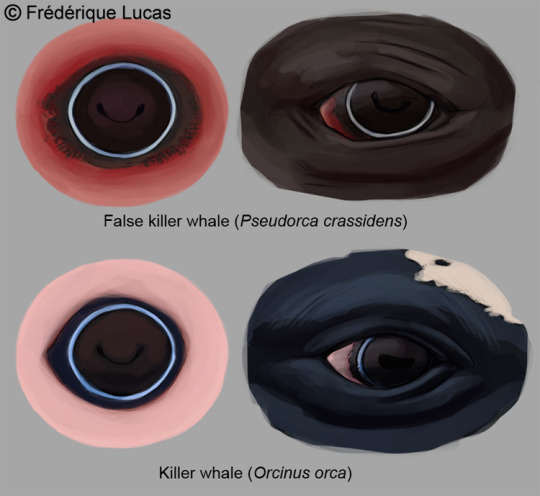
Onto the whale in question. All cetaceans have beautiful brown irises: in many it is an unbelievably rich reddish hue when sunlight hits it directly. In shadow or underwater it looks more subdued though. Then comes the pale ring which in Killer whales is quite variable: in some animals it is very pale, almost white, while others have beautiful bright blue rings. The sclera appears two-toned in blackfish as far as I've seen. Killer whales have a rather modest dark brown area of sclera around the iris-pale-ring-combo, with the surrounding "base" sclera reddish pink. For comparison, False killer whales (Pseudorca crassidens) have a bit more substantive dark brown sclera area, with the surrounding sclera a striking bright red.
I hope this answers your question! This makes me want to finish this chart haha so maybe that'll come soon-ish in its totality.
#namtalk#illustrations#eye colour#cetacean eyes#killer whale eye#dolphin eye#Killer whale#Orcinus orca#False killer whale#Pseudorca crassidens#Harbour porpoise#Phocoena phocoena#Pseudorca#Orcinus#Phocoena#Orca#blackfish#information#tutorial#sort of?
2K notes
·
View notes
Photo

DEAR FRIENDS. My apologies for another enormous silence. After the Delphinus delphis colour anomalies poster I’ve been wanting to make something similar for, well... everything else. It’s a lot of fun going through all sorts of species!! However it’s also a lot lol. Maybe “draw everything first, then figure out how you want to organise this” isn’t the greatest strategy, but here we are. Hence the lack of uploading (though part of that is also just me being busy and scramble brained).
Anyway, consider this a preview for all the ODD BOIS which are - slowly but surely - coming your way. I think they’re super fascinating and I hope you’ll find them too!!
#namtalk#i'm still alive i swear#every time i finish something I go and from now on I'll upload consistently again! and also fail lol#i hope the intermittent posting is also good enough#i don't care so much about being quiet on facebook and deviantart#but tumblr feels more like family#anyway i hope you like the sneak peek at all the oddities#and fingers crossed i'll have something concrete to show soon!
80 notes
·
View notes
Note
Has there been a case of a hybrid between a bottlenose and an Atlantic spotted dolphin?
Perhaps! No one knows for sure. There has been no definitive proof from DNA samples of wild animals, nor has it ever been confirmed in captive animals. However, there is much reason to believe it is plausible, and one possible hybrid has been observed.
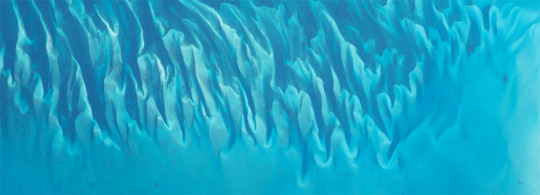
Let me take you to The Bahamas. Specifically, Great Bahama Bank and Little Bahama Bank. They're sprawling sandbanks surrounding the islands, and many Atlantic spotted dolphins as well as coastal Common bottlenose dolphins make their home there. The spotted dolphins have been studied for more than 30 years by Denise Herzing and her associates. While by far the most encounters are with single-species groups, there have been dozens of mixed species encounters as well.
Many of these are aggressively sexual in nature, with males of both species sparring and trying to enter each other. Male bottlenose dolphins often seem to dominate the smaller spotted dolphins during these encounters, though the spotted dolphins have been seen retaliating, and it is speculated they don't actually experience the harassment as very negative. Since much of the action is male-on-male or involves juvenile animals not yet sexually mature, it seems in many cases the nature of these encounters is more social than sexual. However, multiple cases of interspecific male-on-female copulation have been observed.
With so much going on, the potential for hybridism is great. And since the two species are morphologically quite similar (especially when young), a hybrid could easily fly under the radar.
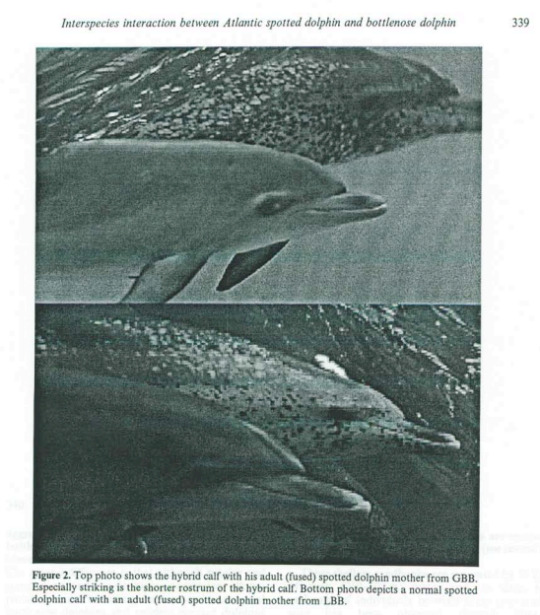
In February of 2003, Herzing and her team observed a female spotted dolphin with an unusual looking calf. The calf had a shorter rostrum than is normal for spotted dolphins in the area, but it was longer and more elegant than that of a Bahamian bottlenose. Herzing assumed it could be a hybrid calf. However, since no DNA testing was done and the calf was only observed for two days, this can't be confirmed. In 1989 and 1996 there have also been observations of female spotted dolphins mothering over bottlenose dolphin calves. In one case the calf was emaciated, and the spotted dolphin swimming with it wasn't lactating, so most likely the calf died. In another case it was only a temporary association and the bottlenose calf returned to their real mother after a while.
So a lot of interesting things going on. The studies are still ongoing. To my knowledge no large scale DNA testing has been done, nor any new "suspect" animals observed. Perhaps in the future a hybrid will be confirmed! Or perhaps it turns out this is one of those mixes that just doesn't work.
I highly recommend you read the study the photo comes from: "Interspecies interactions between Atlantic spotted dolphins, Stenella frontalis and bottlenose dolphins, Tursiops truncatus, on Great Bahama Bank, Bahamas". And many of the other studies done by Denise Herzing's team can be read for free here: https://www.wilddolphinproject.org/media/scientific-publications/
#namtalk#hybridism#hybrid#dolphin hybrid#Common bottlenose dolphin#Tursiops truncatus#Atlantic spotted dolphin#Stenella frontalis#dolphin#The Bahamas#Great Bahama Bank#Little Bahama Bank#Denise Herzing#Wild Dolphin Project
128 notes
·
View notes
Text
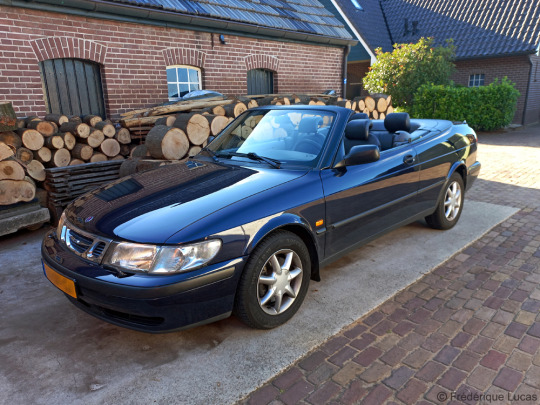
Today Blue Sheep turns 24. It's funny, a few years ago I couldn't imagine even wanting to drive a car, let alone enjoying it. Now, this lovely old Saab means so much to me, and I couldn't imagine going without. Driving with the top down on these warm summer days brings me so much joy. And being able to improve and repair her with my own hands gives a sort of intimate satisfaction. Over 1,5 years and almost 25,000 kms together now. I hope for many more.
Happy birthday you beautiful machine.

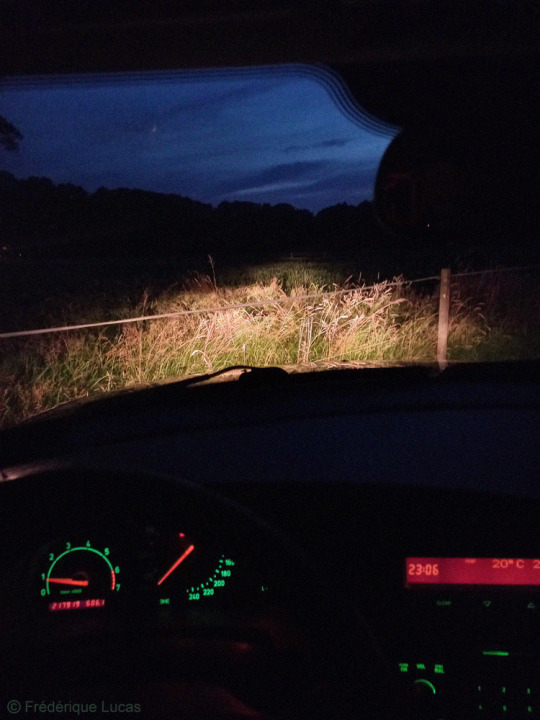
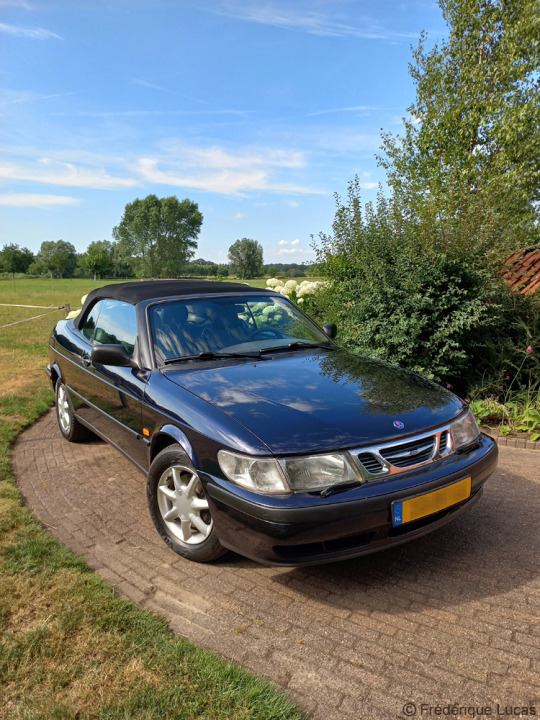
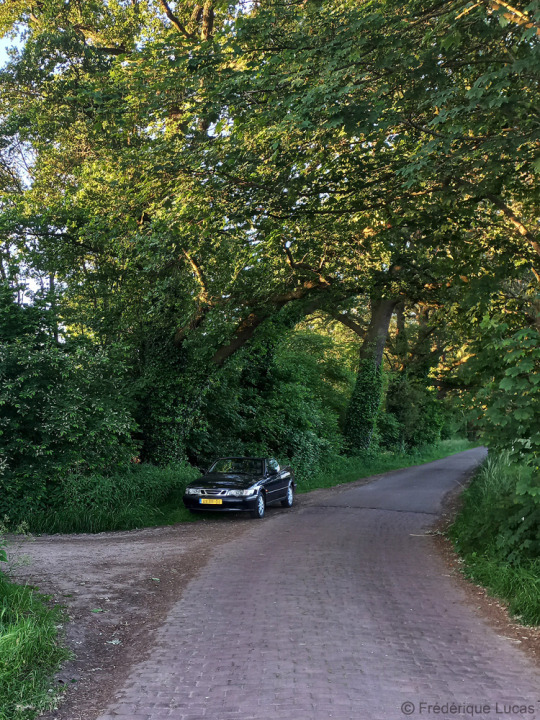

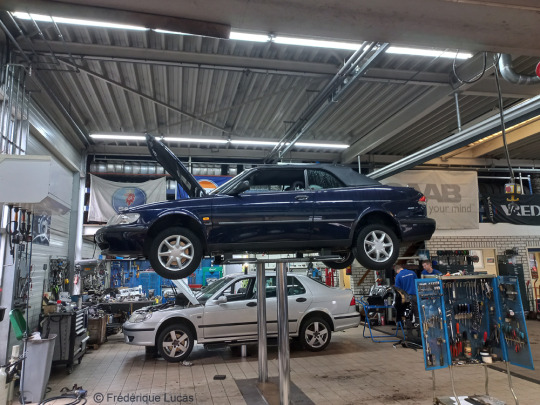


#namtalk#Saab#9-3#convertible#car#photography#to some this may seem a bit weird#but you animism people out there know what's up#cars are a kind of animal too#and that they would let us drive them around#protecting our small bodies as we hurtle along at speeds we could never manage alone#i think that's beautiful#photos
47 notes
·
View notes
Note
I love you artwork so much and it is always so detailed and interesting. I was also wondering if you do commissions?
Ahh thank you so much!! The internet is such a vast place and the thought that somehow some people end up seeing my things and like it is a happy thought ;w;
Yes I am certainly open to commissions!! You can find all info here: https://frederiquelucas.com/commission-information/ Take the prices for full paintings with a grain of salt, as it says in the text each project is unique and I'm always happy to try and find something fitting for someone's budget ♥
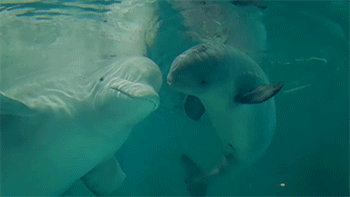
9 notes
·
View notes
Note
Regarding the anti-zoo post I have a question: wouldn't roaming be considered a form of enrichment tho?
Surviving, planning, hunting, thinking for themselves and having new experiences every day, family, herd dynamics, etc. I can't imagine an animal that is "built" to travel long distances and taking care of itself being happy with lying around all day with little to nothing to do. Prey animals might be content, but I can't imagine the same for predators.
Yeah for sure! But this is exactly why a strong enrichment programme is such a crucial part of any good husbandry plan. What kind of enrichment, and how much, depends of course on the needs of a species. But caretakers and trainers work very hard to make sure both the physical and mental needs of their animals are met.
To focus on cetaceans, this can start with the environment itself: some oceanic habitats have the influence of waves and tides, and are often filled with live fish and other naturally occurring wild animals. These provide ever-changing surroundings with lots of "entertainment" and even hunting options. But also a seemingly boring plain tank environment isn't always the same. The weather changes, birds may perch on the edge, there could be cleaning activities going on or special visits from groups/tours.
In a more barren environment the use of EED's (environmental enrichment devices) can be an important part of keeping its occupants entertained. At the Dolphin Academy in Curacao where I volunteered for a short while, the EEDs weren't very exciting and only seldom used because the dolphins could entertain themselves all day within their natural enclosures. But in other facilities, making EEDs for the animals has been turned into an artform. (See for example these contraptions!)
Training, husbandry sessions and shows are all a form of enrichment too! It allows the animal to get a physical workout, while putting their brain to work at the same time. It's also very rewarding for dolphins just for the social interaction of it: I've seen fully milk dependent calves desperate to join a session, without there being any food reward involved for them. And, not to forget: they still live in a social grouping. The interaction between their peers, social structure and hierarchy, play, fights, cooperation... this enriching aspect of social life still exists in a zoo or aquarium.
So in essence, animals under human care definitely "lose" some enriching aspects of their wild life. However, if cared for well, this void is filled up with new and different activities that keep them physically and mentally healthy. There's a whole science dedicated to making sure animals under human care lead interesting lives! Sea World Australia has a great page about all the ways they use enrichment to keep their animals happy and shows examples (plus many more) of the things mentioned above.
#I hope this answers your question a bit!#if not feel free to shoot another ask#also if anyone with more/better/actual experience working in a zoo or marine park wants to add to this - please do!#my knowledge of cetacean care and welfare is mostly theoretical and only a small bit practical#zoos#cetacean captivity#animal welfare#namtalk
15 notes
·
View notes
Note
your blog is so excellent! the mix of educational content and beautiful art is something i feel very lucky to find! keep doing what you’re doing!!- a fellow orca enthusiast
Oo thank you ♥♥ It's so much fun to do both. Sometimes my brain goes science mode and 'let's draw 1000 super specific variations in clean illustrations' and sometimes i have feelings and want to capture a story in a painting. And I'm so glad I can share both with so many wonderful people!!

15 notes
·
View notes
Video
IT IS CAMERA INSPECTION TIME, LADIES AND GENTS
a.k.a. I tried to take a video of my budgie and he Found Out
#video#namtalk#my pets#budgie#budgerigar#i don't often post photos/vids of my pets but this one just made me laugh too much#mlem mlem mlem
29 notes
·
View notes
Note
Oh my god I'm in LOVE with your scientific illustrations!!!! Thank you so much for sharing them here for all of us to see!! Incredible work :)
Thank YOU so much for your kind message!! In the past I've often felt that my scientific illustrations get less love for being less artsy or evocative. But I'm so glad to see they've found their appreciators here ♥♥ Plus I really love making them!! It's such a cool way to share weird and wonderful oddities and variations.

12 notes
·
View notes
Video
From one silly man to another: one licks the glass while the other does a heckin concern.
That’s my budgie Pinky btw, he’s 11 years old and I’ve had him since I was little.
55 notes
·
View notes
Video
Me: this is a finger
My betta:

Don’t know why but felt like posting some pet videos. This is my betta, he doesn’t have a name (yet) but if you could pour the spiritual essence of a himbo into a fish, this would be it. Like, this is the guy who somehow got himself stuck - not once, but twice - in the filter compartment of his paludarium, then after I freed him got angry at a pygmy cory out of sheer indignity, and literally 30 seconds later was eyeing up the filter grate again like

He’s real pretty though so it’s okay. He started out almost completely white btw, pretty cool to have seen him change colour. PLS LOVE MY FISH BECAUSE I LOVE HIM TOO
#namtalk#video#my pets#betta#i've never really owned a betta before#well when i was little and didn't know an awful lot about aquariums yet#and they were kinda sickly standard pet store betta girls#so himbo feels like a first#and GOD I love them#i currently have a tank as dedicated nursing home to grandpa the mean old fish#but if he ever kicks the bucket I want another betta#they're so silly
24 notes
·
View notes
Note
Did you take courses/classes in scientific illustrations? If so, how did you go about it? What sparked your initial interest?
Hi! Thank you for your question ♥ No, I did not take any courses or classes in scientific illustration, or art in general. It's really just a passion that has grown ever since I was little. I've always loved dolphins, but what really sparked my interest in scientific illustrations is the book "Whales, dolphins and Seals" written by Hadoram Shirihai, and illustrated by Brett Jarrett. The very first cetacean field guide I owned.
I loved that book, to the point where I jokingly christened it "the whale bible". And it was all down to those illustrations. Brett had taken so much care to illustrate everything. All variation you could think of; males, females, juveniles, calves, subspecies, different populations - four pages of spinner dolphins, four pages of killer whales - it was mesmerizing. (Brett’s art in general is gorgeous btw; his bird art especially is stunning and totally worth checking out)
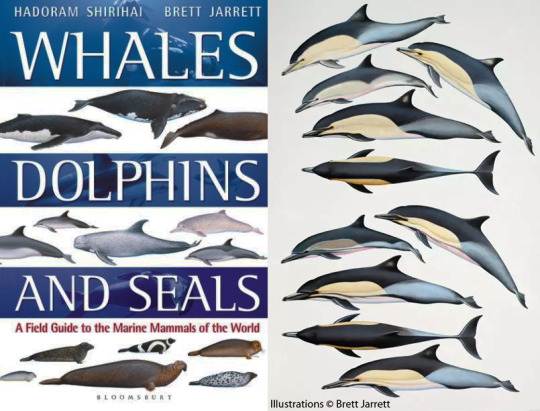
At first I started out more or less copying pages from the book, making overviews of single species. A second field guide joined my collection, and at one point I started a project to illustrate all cetaceans of the world. All drawn with pen and pencil, all horrible of course. But the attempts to colour some of those drawings digitally, in Photoshop, are in fact the start of my scientific illustration career.
Here's some of those frail beginnings; a common dolphin 'ID sheet' from 2009 (which I don't think I've ever shared online before!) a page with small blackfish species from the whale guide project, plus two digitally coloured pages of the same thing, both from 2010.


Personally, I don't think a formal education is necessary at all to do this job. If you're passionate about it, go for it. Practise, find your way, connect with others int he field and stand out with your style, your attention to detail, your technique. You'll get there!
119 notes
·
View notes
Photo
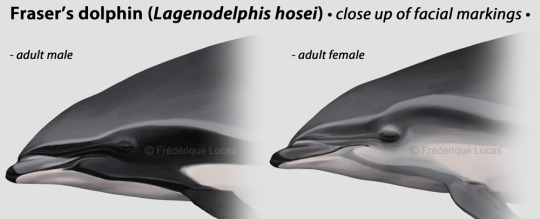
Hey everyone, sorry for being so quiet in the art department. I see my last post was from august(!!) and that wasn’t even a recent piece then :0 Thing is I’ve been very busy with commissions: one was a loooong standing painting of a steam loco, which I’m very happy to have finished after more than a year of on-and-off work. However it’s a gift so I’ll have to double check if/when I can share it online. And right now there’s two big project happening simultaneously which sadly I can’t talk about yet - but know they both involve a lot of cetacean illustrations. So I’m more than pleased ♥ Luckily I can show the illustrations for one of the projects so I’ll do my best to share some WIPS and finished pieces as I work on them!
Most recently I finished two illustrations of the Fraser’s dolphin, and frankly, I may have fallen in love a little bit. LOOK at those gorgeous markings! I just love how even within the male’s black mask you can find delicate eyestripes, and the females just have this beautiful subtle dark grey version. I hope you’ll love them too.
#wip#illustrations#scientific illustration#Fraser's dolphin#sarawak#dolphin#Lagenodelphis hosei#Lagenodelphis#hosei#digital art#namtalk
45 notes
·
View notes